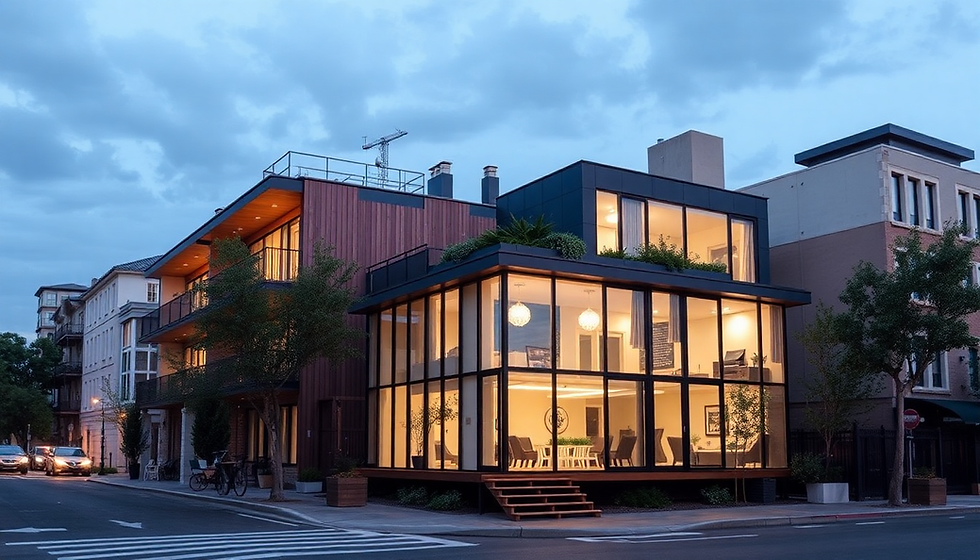The Future of Urban Living: Innovative Housing Solutions
- Phase Zero
- Aug 21, 2024
- 3 min read
Updated: Nov 13
Urban living is evolving to meet the challenges posed by increasing population densities, environmental concerns, and changing lifestyles. Innovative housing solutions are emerging to address these issues, offering sustainable, efficient, and community-oriented living spaces.
Co-Living Spaces
Co-living is a growing trend in urban areas, particularly among young professionals and students. These spaces offer private bedrooms with shared common areas such as kitchens, living rooms, and co-working spaces. Co-living promotes community, reduces living costs, and maximizes the use of available space. Operators of co-living spaces often provide amenities and services, creating a convenient and social living environment.
Modular and Prefabricated Homes
Modular and prefabricated homes are gaining popularity as a quick and cost-effective solution to urban housing shortages. These homes are constructed off-site in controlled environments and then transported to the final location for assembly. This method reduces construction time and waste, offers flexibility in design, and can be more affordable than traditional building methods. Modular homes can be adapted to various urban settings, from single-family houses to multi-story apartment complexes.

Micro-Apartments
Micro-apartments are small, efficiently designed living spaces that make the most of limited square footage. These apartments typically range from 150 to 400 square feet and include multifunctional furniture, smart storage solutions, and communal amenities. Micro-apartments are ideal for single occupants or couples who prioritize location and affordability over space. Developers are increasingly incorporating communal areas, such as rooftop gardens and shared kitchens, to enhance the living experience.
Green Building Practices
Sustainable design is becoming a key focus in urban housing. Green building practices include the use of energy-efficient materials, renewable energy sources, and eco-friendly construction methods. Features like green roofs, solar panels, and rainwater harvesting systems reduce environmental impact and promote self-sufficiency. These sustainable practices not only benefit the environment but also reduce utility costs and improve the quality of life for residents.
Vertical Gardens and Green Roofs
Integrating green spaces into urban housing developments is essential for enhancing biodiversity, improving air quality, and providing recreational areas for residents. Vertical gardens and green roofs transform underutilized spaces into vibrant, green oases. These features can be incorporated into residential buildings, providing residents with access to nature and outdoor spaces without leaving the city. Green roofs also offer insulation benefits, reducing energy consumption for heating and cooling.

Smart Home Technology
Smart home technology is revolutionizing urban living by enhancing convenience, security, and energy efficiency. Smart systems control lighting, heating, and security, adapting to residents' preferences and schedules. For example, smart thermostats learn user behavior and adjust temperatures accordingly, while smart lighting systems can be controlled remotely or set to change based on natural light levels. These technologies make urban homes more efficient and comfortable.
Mixed-Use Developments
Mixed-use developments combine residential, commercial, and recreational spaces in a single area, creating vibrant, self-sufficient communities. These developments reduce the need for long commutes, promote local businesses, and encourage social interaction. Residents have easy access to shops, restaurants, and entertainment, enhancing the convenience and appeal of urban living.
Adaptive Reuse of Buildings
Adaptive reuse involves repurposing existing buildings for new uses, preserving historical architecture while meeting modern housing needs. This approach reduces construction waste, maintains the cultural heritage of urban areas, and often provides unique and character-filled living spaces. Examples include converting old factories into loft apartments or transforming warehouses into residential complexes.

Affordable Housing Initiatives
Addressing the affordability crisis in urban areas is crucial. Innovative financing models, public-private partnerships, and community land trusts are being used to develop affordable housing projects. These initiatives aim to provide high-quality, affordable homes for low- and middle-income residents, ensuring that cities remain inclusive and diverse.
Community-Focused Design
The future of urban living emphasizes community and social connections. Housing developments are being designed with communal spaces, shared amenities, and social programs that encourage interaction and collaboration among residents. Community-focused design fosters a sense of belonging and improves the overall quality of life.
In conclusion, innovative housing solutions are transforming urban living, making it more sustainable, efficient, and community-oriented. By embracing these trends, cities can provide high-quality living environments that meet the needs of their residents and promote a better quality of life.
If you're looking for ways to make your home more sustainable, feel free to reach out to our team of experts. PhaseZero can help you enhance your home's functionality while maintaining the beauty and comfort of your living environment.



